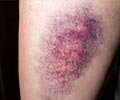The half-clad and boisterous cheerleaders are becoming a matter of concern. No, not for the moral brigade. For the medical community. For the girls are increasingly vulnerable to serious injuries.
The half-clad and boisterous cheerleaders are becoming a matter of concern. No, not for the moral brigade. But for the medical community. For the girls are increasingly vulnerable to serious injuries.
Newsweek has dubbed cheerleading the most quintessential of US sports. It involves elements of tumbling, dance, jumps and stunting. Even international competitions are held, and many young girls aspire to become cheer leaders. US media encourages them in a big way.Now comes the bad news. Cheerleading is becoming one of the riskiest athletic activities for women, leaving a long trail of sprained wrists, twisted ankles, damaged knees, strained backs, writes Rob Stein in Washington Post.
Krista Parks was practicing with her cheerleading team when something went terribly wrong. Instead of flipping smoothly through the air and landing safely in the arms of a teammate, Parks plummeted 20 feet headfirst into the gym floor, fracturing three vertebrae in her neck.
"Immediately I went numb," said Parks, a 21-year-old University of Memphis junior at the time. "All I could feel was tingling from my head all the way down to my feet. I thought: 'I'm paralyzed.' "
Miraculously, Parks escaped permanent paralysis. But five years later, after nearly a month in the hospital, multiple surgeries, physical therapy and more, Parks has learned to live with unrelenting pain in her neck, back and head, irreparable nerve damage and memory problems.
"I'm kind of an example of the unspoken evil of what can happen in cheerleading," Parks said.
The most recent catastrophe occurred in April, when Lauren Chang, 20, of Newton, also in Massachusetts, died after apparently getting kicked in the chest during a cheerleading competition involving a team she had joined at a local gym.
While cheerleading proponents acknowledge that more could be done to improve safety, they dispute claims that the activity is unusually risky.
"When it's done properly, cheerleading is as safe as any other sport that kids can take part in," said Jim Lord, executive director of the American Association of Cheerleading Coaches and Administrators. "I don't want to minimize the fact that there are risks, and injuries can occur. I just think it has to be put into perspective."
Concerns about cheerleading safety arise whenever a high-profile accident occurs. But alarm spiked again this summer when the National Center for Catastrophic Sports Injury Research, which has been tracking sports safety nationwide for 25 years, reported that cheerleading accounted for two-thirds of all catastrophic injuries among female high school and college athletes.
The total number of "catastrophic" incidents, defined as death or serious injury, such as head or neck damage leading to permanent disability, was relatively small. The center documented just 93 such cases between 1982 and 2007: 67 that occurred among high school students and 26 in college. And although other sports, such as football, produce far more devastating injuries, Mueller, who runs the center, calculated that the numbers translate into a rate of 2.68 catastrophic injuries for every 100,000 female high school cheerleaders, which exceeds the rate for many other high school sports.
"This tells you that cheerleading is dangerous -- even more dangerous than football when it comes to the rate," said Mueller, noting that because there is no reporting system for cheerleading accidents, the problem is probably worse. "I think it's a serious problem, and it has to be looked at. I think cheerleading has to make some dramatic changes."
Based on emergency room data from 114 hospitals, the Consumer Product Safety Commission estimated that the number of emergency room visits to treat cheerleading injuries of any kind jumped from 4,954 in 1980 to 28,414 in 2004. Similarly, a study published in the journal Pediatrics in 2006 calculated that the number of children showing up in emergency rooms with cheerleading injuries rose from 10,900 in 1990 to 22,900 in 2002, a 110 percent increase.
The most common injuries were arm and leg strains and sprains, but 3.5 percent of the cases involved head injuries.
Cheerleading "has the potential to be very dangerous," said Brenda J. Shields, who runs the Center for Injury Research and Policy at Nationwide Children's Hospital in Columbus, Ohio, and led the Pediatrics study.
The main problem, critics say, is that cheerleading in most states is not considered a sport; it's an "activity" such as chess club and debating. As a result, it is not required to follow uniform safety regulations, such as mandating off-seasons, routine physicals and soft surfaces that would minimize injuries. Coaches are not required to undergo standardized training.
In addition to thousands of junior high, high school and college squads fulfilling their traditional role of cheering on football, basketball and other teams, competitive cheerleading teams, many organized by private gyms and some of them fighting for prize money, have been proliferating across the country, increasing the number of participants sharply. The intensifying competition has been pushing teams to attempt increasingly complex stunts.
"One set of rules and regulations doesn't apply to all the different teams that are out there," Shields said.
Some organizations issue safety guidelines that are updated annually. For example, this year's rules recommend against "basket tosses" (in which multiple teammates throw a cheerleader spinning into the air) on a hard basketball court floor.
Cheerleading "should be treated like other sports in terms of having a qualified coach and following safety rules to put children in a safe position," Lord said. "It comes down to following those rules."
Several organizations also offer training programs for coaches, including how to minimize risks, teach stunts properly and respond to medical emergencies.
"Our mind-set is still set in the '70s. People think of the girls in short little skirts waving pompoms. But they are finely honed athletes. We need to make sure they are getting the coaching that will keep them safe and keep that coaching on an elevated level," said Debbie Bracewell, executive director of the National Council of Spirit Safety and Education.
Lord acknowledged that the rules and the training of coaches vary significantly and that some teams are attempting dangerous stunts without adequate preparation and safeguards.
"We're seeing more kids trying skills they shouldn't try. That's where the injuries occur. When we see that and see an increase in injuries, we make a rule change and say regardless of what your team can do we're not going to allow it," Lord said. "I want to make sure we have qualified coaches in place. We also need parents to be involved to make sure they are following the rules. And the kids who participate have to recognize there is risk involved."
Source-Medindia
GPL/SK
 MEDINDIA
MEDINDIA

 Email
Email




